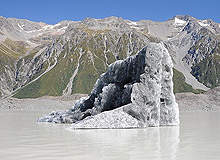
As delegates from all over the world endeavour to agree a policy on climate change in Cancun, Mexico, the very process that is at the core of the discussion is opening up the Arctic for oil and gas exploration and production. There are issues with which nation has rights to what, issues with operating in the delicate Arctic environment and issues with post Deepwater Horizon concerns over deepwater drilling.
An oil event in the Arctic, such as the stricken Gulf of Mexico rig, would pose a, “nightmare”, scenario, as the oil released into the frigid northern waters would break up and evaporate much more slowly and that is even before the operating conditions of freezing weather and ice littered high seas are taken into account.
Inestimable reserves
In 2008, the US Geological Survey (UGS) said there could be 90 billion barrels of oil within the Arctic Circle and around 1,670 trillion cubic feet (tcf) of natural gas; the majority of these resources could be offshore. Driven by those estimates, energy companies with deep enough pockets are increasingly attracted to the Arctic. governments have and will no doubt in the future impose drilling moratoriums on areas of the Arctic. However, some areas are already, “open for exploration”.
In November, 2010 Rosneft revealed that it was looking into the possibility of a joint venture with China National Petroleum (CNPC) with the focus being Russia’s offshore hydrocarbons, initially in the sub-arctic Okhotsk Sea, which is thought to contain 5% of Russia’s oil and gas reserves; around 90% of the nation’s recoverable reserves are thought to be in the Arctic region. Russia, the world’s number-one crude oil exporter, is likely to commence exporting oil to China in 2011 via the East Siberian-Pacific Ocean pipeline.
See Also:
For the US, Canada, Norway and Russia, “fear of the unknown” looms large in the political mindset.
How well do you really know your competitors?
Access the most comprehensive Company Profiles on the market, powered by GlobalData. Save hours of research. Gain competitive edge.

Thank you!
Your download email will arrive shortly
Not ready to buy yet? Download a free sample
We are confident about the unique quality of our Company Profiles. However, we want you to make the most beneficial decision for your business, so we offer a free sample that you can download by submitting the below form
By GlobalDataA US presidential commission is looking into the events sparked off by Deepwater Horizon and recently focused on the Arctic and how to deal with possible spills; no conclusions have yet been drawn.
Canada, Norway and Russia have leased offshore areas for development, yet none of the nations are reported to have actively developed anything; Canada and Norway are waiting for the findings on the Deepwater Horizon. While those findings may be some way off yet, the US Department of the Interior (DoI) did release a revised outer continental shelf (OCS) leasing programme on 1 December 2010. Secretary of the Interior Ken Salazar’s modifications are based on lessons learned from Deepwater Horizon. For the US Arctic area, while other areas are still under a moratorium, “the Chukchi and Beaufort Seas in the Arctic will continue to be considered for potential leasing before 2017,” said the DoI.
Drilling on ice
Although no further leases sales will be conducted in the Chukchi and Beaufort Seas under the 2007-2012 programme, according to the DoI, the Bureau of Ocean Energy Management, Regulation, and Enforcement (BOEMRE) will honour existing leases and is looking at one pending application by Royal Dutch Shell to drill a single exploratory well in the Beaufort Sea. The application is being processed by BOEMRE, which is working closely with the National Oceanic and Atmospheric Administration (NOAA).
Should Shell’s application be approved, BOEMRE will have safety personnel on-site monitoring drilling operations and says it will hold Shell accountable for, “compliance with BOEMRE’s drilling safety and environmental regulations”.
On the face of it, further development for energy companies in the US region of the offshore Arctic is not coming anytime soon. However, US economic pressures and a political shift as the Republicans take control of the US House of Representatives in January 2011 could have an effect on speeding up US Arctic offshore activities.
In Greenland’s chilly Arctic waters, the situation is a little different. The island nation, controlled by Denmark, has reportedly granted 13 licences since 2002 to its own state owned company, Nunaoil and also to Cairn Energy, Dong Energy, ExxonMobil, Encana, Husky Energy and PA Resources.
Towards the end of November 2010, Greenland awarded seven oil and gas exploration licences covering an area of nearly 71,000km² to AP Moeller-Maersk, Cairn, ConocoPhillips, Dong Energy, GDF Suez, Nunaoil, Statoil and Shell.
“The companies that have been awarded a licence were selected according to a thorough evaluation of, for example, their financial and technical strengths, and their experience in managing safety, health and environmental issues,” said Ove Karl Berthelsen, Greenland’s minister for Industry and Mineral Resources.
The sea around Greenland may hold up to 50 billion barrels of oil and gas equivalent according to the UGS. However, it will be time consuming and costly to pin the energy resources down. Cairn Energy, in its drilling update for Greenland in October 2010, reported mixed success for two wells. Nevertheless, Mike Watts, deputy chief executive, Cairn Energy said, “Exploration in Greenland is at a very early stage and consequently to have encountered both gas and oil in two of the first frontier exploration wells in the previously undrilled Baffin Bay geological basin is extremely encouraging.”
Statoil has interests in sub-Arctic offshore areas around Norway, Russia and Canada. In the latest Greenland permit round the company has been awarded two large exploration blocks amounting to over 20,000km²; Shell will be the operator for both blocks.
“These awards increase the optionality of our exploration portfolio,” said Tim Dodson, Statoil’s senior vice-president for global exploration. “While early access to such frontier opportunities entails more uncertainties related to probability of discovery, the potential reward of one or more sizeable discoveries may be high,” he added. “Together with our partners, we will use all of our experience and competence from more than 30 years of oil and gas operations in harsh environments on the Norwegian continental shelf.”
Success is by no means certain in the region as Statoil well knows. The company drilled an exploration well in the Fylla area to the west of Greenland during the last decade and came up dry; Statoil reportedly relinquished its exploration licence for Fylla in 2002. Further Arctic oil and gas development is not going to be easy or cheap and working conditions will border on the horrendous. However, the easy energy is all but gone or spoken for, and to keep our new age economies afloat, to the frontiers we must go.




